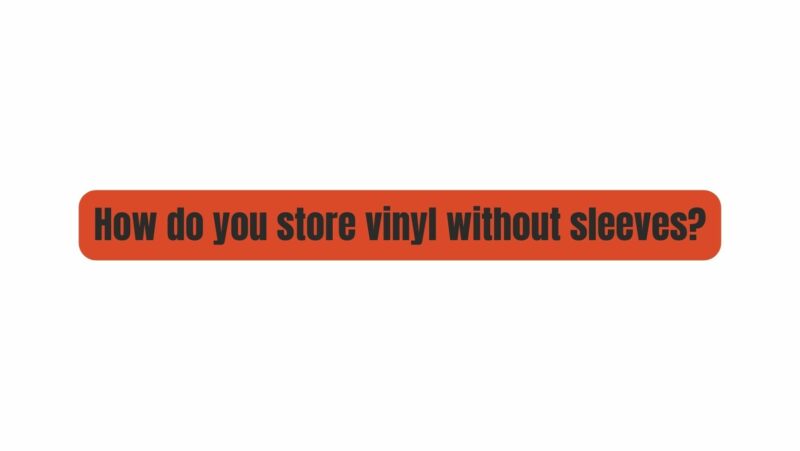Vinyl records have enjoyed a resurgence in popularity among music enthusiasts and collectors, thanks to their warm, analog sound and tactile appeal. When it comes to maintaining a vinyl collection, proper storage is essential to prevent damage and ensure the longevity of these cherished artifacts. While it’s common practice to store vinyl records in protective sleeves, there may be situations where storing records without sleeves is necessary or preferred. In this article, we will delve into the intricacies of storing vinyl records without sleeves, addressing the risks involved and providing expert guidance on how to do it safely.
Why Store Vinyl Records Without Sleeves?
Before exploring the methods for storing vinyl records without sleeves, it’s essential to understand the reasons behind this choice. There are several scenarios in which collectors may opt for this approach:
- Artwork Display: Many collectors appreciate the visual artistry of vinyl record labels and album covers. Storing records without sleeves allows for the full display of these artworks, enhancing the aesthetic appeal of the collection.
- Access and Convenience: Some vinyl enthusiasts prefer quick and easy access to their records. Removing and replacing sleeves each time a record is played can be time-consuming, leading them to choose to store records without sleeves for convenience.
- Preservation of Outer Covers: In rare cases, collectors may choose to preserve the original outer covers of valuable records separately while keeping the vinyl discs themselves accessible for listening.
- Personal Preference: Ultimately, personal preference plays a significant role in the decision to store vinyl records without sleeves. Some collectors simply prefer the tactile experience of handling bare records.
However, it’s crucial to acknowledge that storing vinyl records without sleeves comes with potential risks, including dust and debris accumulation, scratches, and exposure to environmental factors. To mitigate these risks and preserve your vinyl collection effectively, follow the best practices outlined below.
Best Practices for Storing Vinyl Records Without Sleeves
- Clean Records Thoroughly: Before storing vinyl records without sleeves, ensure they are clean. Use a carbon fiber brush or an antistatic brush to remove dust and debris from the surface. For more thorough cleaning, consider using a dedicated vinyl record cleaning solution and a microfiber cloth.
- Control the Environment: Maintain a stable environment for your records. Keep the temperature between 65-70°F (18-21°C) and the relative humidity between 40-50%. Fluctuations in temperature and humidity can lead to warping and other forms of damage.
- Use Anti-Static Mats: Place anti-static mats or sheets on your record storage shelves. These mats help reduce static electricity, which can attract dust and negatively impact sound quality.
- Store Vertically: Store your vinyl records vertically, just like books on a bookshelf. This prevents warping and minimizes pressure on the records’ surfaces. Avoid stacking records horizontally or leaning them against each other.
- Control Dust: Implement dust control measures in your storage area. Use air purifiers and consider sealing the storage space to minimize dust infiltration.
- Regular Cleaning: Since your records are exposed, it’s essential to clean them regularly. Use a soft, lint-free cloth to wipe away any dust or dirt that may accumulate on the record surfaces.
- Implement a Cleaning Routine: Establish a routine for cleaning your records before and after playback. This helps prevent dust and debris from accumulating over time.
- Use Outer Sleeves for Valuable Records: While the primary focus of this article is on storing records without inner sleeves, consider using outer sleeves for valuable or collectible records. Outer sleeves provide an additional layer of protection against dust and handling damage.
- Handle with Care: When handling records without sleeves, always hold them by the edges and avoid touching the playing surface. Fingerprints and oils can degrade sound quality and affect the visual condition of the record.
- Inspect Your Records: Regularly inspect your records for signs of damage or wear, especially if they are stored without sleeves. Promptly address any issues to prevent further deterioration.
Conclusion
Storing vinyl records without sleeves is a choice that reflects personal preferences and aesthetics. While it allows for the full visual appreciation of album artwork and offers convenience for some collectors, it does come with certain risks, including dust accumulation and potential surface damage. By following the best practices outlined in this article, you can mitigate these risks and maintain the condition of your vinyl collection effectively. Ultimately, whether you choose to store your records with or without sleeves, the key is to handle and care for them with the reverence they deserve, ensuring that your vinyl treasures continue to bring joy and musical magic into your life.


